
在花了大把时间在中国旅行,阅读有关中国的材料,并深入思考有关中国的东西之后,我得出了一个结论:可以说,中国的最深刻的特点,就是这个国家太大了。这听上去或许毫无新意,老实讲,也像是在白白浪费英国《金融时报》的钱财。然而,中国的巨大规模,有助于解释关于这个国家的许多事情:从其对国际大宗商品市场的影响,到人们如今经常把这个全球最贫穷的国家之一与(依然)强大的美国相提并论这一事实——对于生活水平与中国不相上下的萨尔瓦多,人们却漠不关心。
13亿的乘数效应,使中国所做的几乎每件事,都显得出奇重要。在某些方面,巨大的规模,改变了中国面临的障碍和所能创造的机遇的本质。
有些情况下,中国的规模是一个明显的缺陷。不妨以人民币争议和中美贸易顺差为例。实际上,中国一直走的是一条常规的经济腾飞之路。与之前的日本、韩国和台湾一样,中国依靠外部需求开启了工业化进程;为了适合自身发展的需要,对规则进行了有利于自己的曲解。但与那些国家和地区不同的是,中国早早就“被发现了”。日本上世纪80年代与美国发生严重贸易摩擦时,其人民生活水平已几乎赶上了西方。如今中国惹恼了美国国会,可是中国的人均收入——即使按照购买力平价计算——才不过是美国的七分之一。倘若中国的规模只有目前的十分之一,那么谁也不会留心中国(不可自由兑换的)货币的汇率。
在其它领域,规模也于中国不利。中国对石油、铁矿石、矾土、木材等商品的庞大需求,对这些大宗商品市场造成了很大影响。要了解中国的需求有多大,只需看看煤炭。中国只有3%的煤炭依靠进口,但在全球煤炭海运贸易中,中国就占到了五分之一左右。同样,中国消耗着全球约一半的水泥、三分之一的钢铁和四分之一的铝。中国电网每年扩容1050亿瓦,超过了印度全国的发电量。对于中国所依赖的那些大宗商品的价格,这一切即使不是起着决定性作用,也肯定具有实质性的影响。譬如,2008年,中国需求推动油价涨至每桶140美元这一令人不安的水平,其后也一直为油价提供着支撑。
中国对大宗商品的渴求,在商业和外交上也产生了影响。中国认为自己购买铁矿石支付的是垄断性价格,为此愤愤不平,为此,中国出价195亿美元想拿下力拓(Rio Tinto),结果与澳大利亚发生了摩擦。由于担心粮食安全,中国政府支持中化集团(Sinochem)出手阻挠必和必拓(BHP Billiton)对加拿大钾肥(PotashCorp)涉资390亿美元的敌意收购。同样,中国在非洲、中亚、拉美以及其它一些有时怀有敌意的地区,四处寻觅石油和其它资源,使自身陷入棘手的外交政策至于这个世界有没有足够资源——不管价格多高——来满足中国庞大的需求,也存在切实的问题。领域,这有违中国的本意。
要是中国人都像美国人那样过日子,那么不仅夏威夷衬衫和花哨的裤子会严重供不应求,而且,据地球观察研究所(Earthwatch Institute)估计,全球石油日产量必须提高2000万桶,至1.05亿桶;谷物及肉类产量则必须提高三分之二至五分之四之间。
庞大的内部市场,使中国具备规模经济效应,得以发展汽车、高铁等具有国际竞争力的产业。得益于中国庞大的经济规模,香港成为了一个重要的国际金融市场,而不出几年,上海交易所的市值将有望跻身全球三甲。
中国发展到今天的地步,规模起到了至关重要的作用。中国看似源源不断的廉价劳动力,吸引了外国投资和技术。如今,中国熙熙攘攘——似乎也将源源不断——的购物者也具有同样的效应。随着越来越多的民众融入城市劳动大军,中国将有机会把他们转化为本国产品的购买者,从而摆脱至今仍困扰着日本的“出口依赖症”。巨大的规模,意味着中国做什么事都会引起波澜。但正因如此,中国更有可能安全驶出前方风高浪急的水域。
译者/杨远
http://www.ftchinese.com/story/001034985

After a great deal of time spent trave庞大的规模有可能妨碍中国的增长,但也会带来巨大的优势。lling in China, reading about China and thinking deep thoughts about China, I have come to the conclusion that the most profound thing one can say about it is this: China is exceedingly big. This may seem like an awfully trite observation and, frankly, a terrible waste of the Financial Times’ money. But China’s sheer size helps to explain much about the country, from its impact on global commodity markets to the fact that one of the world’s poorest countries is now routinely mentioned in the same breath as the (still) mighty US. El Salvador, a nation with roughly the same standard of living as China, barely gets a look-in.
China’s 1.3bn multiplier effect makes almost everything it does seem extravagantly important. In some cases, its scale changes the very nature of the obstacles that confront it and the opportunities it can create.
China’s size is sometimes a distinct drawback. Take the controversy over the renminbi and China’s trade surplus with the US. In fact, China’s path to economic take-off has been fairly standard. Like Japan, South Korea and Taiwan before it, it has relied on external demand to kick-start industrialisation, bending the rules in its favour when that has suited its development needs. But unlike those countries, it has been “found out” much earlier. By the time Japan was causing serious trade friction with the US in the 1980s, it had all but caught up with western living standards. China is provoking anger on Capitol Hill at a time when its per capita income, even on a purchasing power parity basis, is just one-seventh of US levels. If only China were a 10th the size, no one would even have noticed the level of its (non-convertible) currency.
In other areas, too, size counts against Beijing. Its outsized need for oil, iron ore, bauxite, lumber and so on affects the very commodity markets on which it relies. To get an idea of the scale of Chinese demand, look at coal, where China imports just 3 per cent of its needs. Even so, it accounts for roughly one-fifth of global seaborne trade in that commodity. Similarly, it consumes roughly half the world’s cement, a third of its steel and a quarter of its aluminium. Each year, it adds 105GW of power to its electricity grid, greater than the entire generating capacity of India. All of this has a material – not to say decisive – effect on the prices of the commodities on which it depends. Chinese demand, for example, helped to propel oil to an uncomfortable $140 a barrel in 2008 and has kept a floor under it ever since.
China’s hunger for commodities also has business, as well as diplomatic, consequences. Beijing’s chagrin at paying what it considers monopoly prices for iron ore led it to pounce on Rio Tinto, $19.5bn in hand, causing friction with Australia. It has backed Sinochem’s attempt to trump BHP Billiton’s $39bn hostile offer for Canada’s PotashCorp because of its concerns about food security. Likewise, it has scoured Africa, central Asia, Latin America and sometimes-hostile corners of the globe for oil and other resources, thrusting it into tricky areas of foreign policy before it might have wanted.
There are also genuine questions about whether the world has enough resources – at whatever price – to satisfy China’s gargantuan appetites. If every Chinese person lived like an American, not only would there be a terrible shortage of Hawaiian shirts and loud trousers, but, according to the Earthwatch Institute, it would also mean raising global oil production by 20m barrels a day to 105m and increasing the output of grain and meat by between two-thirds and four-fifths.
The vast scale of China threatens to constrain its growth. But its size also confers great advantage. China’s huge internal market gives it the economies of scale to develop globally competitive industries from cars to high-speed rail. The sheer size of its economy has made Hong Kong a globally important financial market and could, in just a few years, see Shanghai become a top-three exchange in terms of market capitalisation of its listed companies.
China’s size has been crucial in getting it this far. Its seemingly limitless supply of cheap labour was a magnet for foreign investment and technology. Now, its potentially endless queues of shoppers are having the same effect. As more and more Chinese are sucked into the urban workforce, China has the opportunity to turn them into purchasers of its own products, weaning its economy off the export-dependency that still afflicts Japan. China’s size means it can’t do anything without making waves. But it also gives it a much better chance of riding out the rough seas ahead.
没有评论:
发表评论